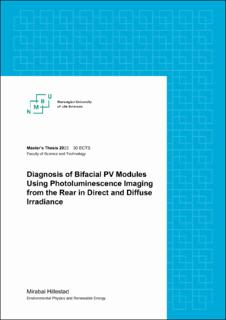| dc.description.abstract | The increasing energy demand has led to a surge in solar power installations. However, solar cells are subject to damage and degradation that may not be visible to the naked eye. Consequently, various techniques have been developed to monitor solar modules to prevent unknown damages from reducing the efficiency of a solar power plant. Photoluminescence has several advantages over other techniques, providing detailed and spatial information on various types of damage in a solar cell module. The technique has been exploited with several approaches, but the built-in IV-curve sweep in the inverter is proven to be a non-invasive diagnostic method that does not disturb the power production.
This thesis explores methods that potentially make photoluminescence diagnostics more efficient, flexible, and/or accurate. The thesis includes experiments on imaging four bifacial PERC modules from the rear side under direct and diffuse light conditions at Søråsjordet in Ås. The thesis also investigates whether the PCC algorithm can increase the accuracy of the images and whether the effect is enhanced with a filtered reference signal.
The results indicate that it is possible to obtain a respectable signal-to-noise ratio from the backside of the modules under both direct and diffuse irradiance, albeit with lower photoluminescence signals than from the front. However, it has been observed that high signals are not necessary to perform an analysis of a processed image of a module.
Several practical challenges were encountered during backside image acquisition that requires further development for the method to be beneficial. The methods are not replaceable for front-side module imaging or direct irradiance image acquisition. However, the analyzable images provide additional information that can be useful for comprehensive diagnostics.
The PCC algorithm was found to produce less noisy images with better separated module and background pixels. This effect was enhanced when the reference signal was smoothed using the Savitzky-Golay filter. | |
